Approaches to Maximize Performance and Reduce the Frequency of Routine Maintenance in ICP-MS
Spectroscopy
This article offers some suggestions for routine maintenance and offers guidance to troubleshoot common problems encountered in the ICP-MS sample introduction area.
This column installment offers some suggestions for routine maintenance and offers guidance to troubleshoot common problems encountered in inductively coupled plasma–mass spectrometry (ICP-MS) sample introduction.
Since inductively coupled plasma–mass spectrometry (ICP-MS) was first commercialized in 1983, it has revolutionized ultratrace multielement analysis. Its combination of low parts-per-trillion (ppt) detection limits, excellent interference rejection capability, and ease of use has meant that routine laboratories can handle high sample workloads in an automated manner with a minimum of operator intervention. However, these strengths often contribute to some of its weaknesses. In ICP-MS, the sample aerosol passes from the sample introduction system into the plasma torch before it enters the spectrometer via the interface. This means that the potential for thermal instability, corrosion, chemical attack, blockage, matrix deposits, and signal drift is much higher than with the other atomic spectrometry techniques. As a result, routine maintenance and regular inspection of instrumental components are critical to reduce the effect of many of these potential problem areas.
For that reason, it’s important to understand where the most common sample introduction-related problems can be found in ICP-MS and to offer some guidance on how best to minimize their impact on the analysis, not only to maximize instrument performance, but also to reduce the frequency of routine maintenance. Understanding these problems becomes critically important in application areas such as the pharmaceutical manufacturing industry, where inexperienced operators are just learning about the capabilities of the technique and are being asked to test products on a routine basis, without having a depth of knowledge about optimizing the instrument’s performance.
Introducing the Sample
It is well-recognized that most problems in ICP-MS occur mainly in the sample introduction system and interface region (1). The sample introduction system is where the sample matrix is converted from a liquid into a fine droplet aerosol that is suitable to be introduced into the plasma to create positively charged ions that then enter the mass spectrometer via the interface region for separation, detection, and measurement. For this reason, it often requires preemptive action to ensure that the instrument is working to its maximum capability, particularly when complex sample matrices are being analyzed. A laboratory that is aware of these potential problem areas by initiating a combination of innovative sample introduction techniques, creative troubleshooting methods, and a realistic approach to routine maintenance, should have an instrument that is ready and available for analysis whenever it is needed.
Figure 1 is a generic schematic diagram of an ICP-MS system showing the major instrumental components. Figure 2 is a close-up of the sample introduction area, which is circled in Figure 1.
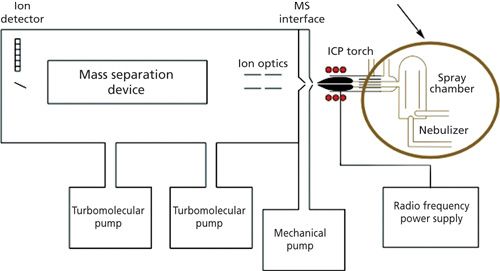

Let’s take a closer look at these individual areas, how they work, and the potential weaknesses that a user needs to pay attention to. These areas should be very similar with all commercial ICP-MS systems, but depending on the design of the instrument and the types of samples being analyzed, the regularity of changing or cleaning components might be slightly different. Several main areas require inspection and maintenance on a routine or semiroutine basis:
- Sample delivery system
- Nebulizer
- Spray chamber
- Plasma torch
- Interface region
Sample Delivery System
There are many different ways of introducing a liquid into an ICP-MS, but they all basically achieve the same result, which is to generate a fine aerosol of the sample with some kind of nebulization system so that it can be efficiently ionized in the plasma discharge (1). The sample introduction area has been called the Achilles’ heel of ICP-MS because it is considered the weakest component of the instrument. Only about 2% of the sample finds its way into the plasma, depending on the matrix and method of introducing the sample. Although there has recently been significant improvement in this area, the fundamental design of a traditional ICP-MS sample introduction system has not dramatically changed since the technique was first introduced in 1983. The sample delivery system, comprising the peristaltic-pneumatic pump, nebulizer, spray chamber, and drain system, takes the initial abuse from the sample matrix, and as a result, is an area in the ICP-MS system that requires the most care. Now, let’s examine what kind of routine maintenance is required.
Sample Capillary-Pump Tubing
The sample is sucked up from the sample container, either by natural venturi aspiration of the nebulizer or pumped with a peristaltic or syringe pump at a flow rate of approximately 1 mL/min. If a peristaltic pump is used, the constant motion and pressure of the pump rollers on the pump tubing, which is typically made from a polymer-based material, ensure a continuous flow of liquid to the nebulizer. However, over time, this constant pressure of the rollers on the pump tubing has a tendency to stretch it, which changes its internal diameter and, therefore, the amount of sample being delivered to the nebulizer. The impact could be a change in the analyte intensity and degradation in short-term stability.
Therefore, the condition of the pump tubing should be examined every few days, particularly if your laboratory has a high sample workload or if extremely corrosive solutions are being analyzed. The peristaltic pump tubing is probably one of the most neglected areas, so it is absolutely essential that it be a part of your routine maintenance schedule. Here are some suggested tips to reduce pump tubing-based problems:
- Manually stretch the new tubing before use.
- Maintain the proper tension on tubing.
- Ensure tubing is placed correctly in channel of the peristaltic pump.
- Periodically check the flow of sample delivery, and throw away tubing if in doubt.
- Replace tubing if there is any sign of wear; do not wait until it breaks.
- With high sample workload, change tubing every other day.
- Release pressure on pump tubing when instrument is not in use.
- Pump and capillary tubing can be a source of contamination.
- Pump tubing is a consumable item-keep a large supply of it on hand.
A syringe pump is an alternative approach to delivering the sample to the nebulizer. The benefits of using a syringe-type pump for autodilution and the on-line addition of internal standards are well recognized in ICP-MS. Combining a syringe pump with a switching valve significantly improves precision by eliminating the pulsations of a peristaltic pump and allows shorter measurement times to achieve the same performance levels, as exemplified in Figure 3 (2).
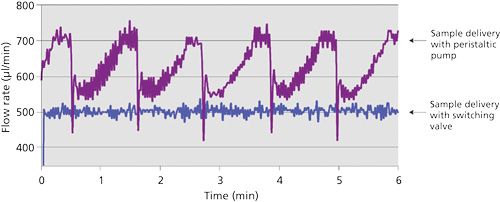
A very useful tool to diagnose any problems associated with sample blockage in the tubing or the nebulizer is a digital thermoelectric flowmeter (3). By inserting a flowmeter in the sample line, you always know the actual rate of sample uptake to your nebulizer. The addition of a flowmeter enhances the day-to-day reproducibility of your results and reduces the need to repeat measurements because of a blocked nebulizer, worn pump tubing, or incorrect clamping of the pump tube.
Nebulizers
The frequency of nebulizer maintenance will primarily depend on the types of samples being analyzed and the design of the nebulizer being used. For example, in a cross-flow nebulizer, the argon gas is directed at right angles to the sample capillary tip, in contrast to the concentric nebulizer, where the gas flow is parallel to the capillary.
The larger diameter of the liquid capillary and longer distance between the liquid and gas tips of the cross-flow design make it far more tolerant to dissolved solids and suspended particles in the sample than the concentric design. On the other hand, aerosol generation of a cross-flow nebulizer is far less efficient than that of a concentric nebulizer, and therefore it produces droplets of less optimum size than that required for the ionization process. As a result, concentric nebulizers generally produce higher sensitivity and slightly better precision than the cross-flow design, but are more prone to clogging, especially if there is particulate matter in your samples (4).
The choice of which nebulizer to use is usually based on the types of samples being aspirated and the data quality objectives of the analysis. For example, if your samples contain high levels of dissolved solids, select a nebulizer that has a tolerance for high levels of solids. Whichever nebulizer type is being used, attention should be paid to the tip of the nebulizer to ensure it is not getting blocked. Microscopic particles can build up on the tip of the nebulizer without the operator noticing, which can result in imprecision, loss of sensitivity, and poor long-term stability. For these reasons, the nebulizer should always be a part of the regular maintenance schedule. Some of the most common tasks to carry out include
- Visually check the nebulizer aerosol by aspirating water-a blocked nebulizer will usually result in an erratic spray pattern with lots of large droplets.
- Remove a blockage using back pressure from argon line or use a commercially available nebulizer cleaning device. Dissolving the blockage by immersing the nebulizer in an appropriate acid or solvent can be used to aid dissolution, but check with the manufacturer first in case it is not recommended. (Note: Never stick any wires down the end of the nebulizer, and do not sonicate glass nebulizers, both of which can result in permanent damage.)
- Ensure that the nebulizer is securely seated in the spray chamber by checking all O-rings for damage or wear.
- Ensure the sample capillary is inserted correctly into the sample line of the nebulizer.
- The nebulizer should be inspected every 1–2 weeks, depending on the workload and sample types.
The digital flowmeter described earlier is also very useful to diagnose problems with the nebulizer, because you always know what your sample uptake is and can take immediate corrective action if there is any change. You can also record the sample flow to check that you are using the same flow from day-to-day. If the flowmeter indicates a blocked nebulizer tip, one of the commercially available cleaning tools should be used to safely and efficiently deliver a pressurized cleanser through the nebulizer capillary to dislodge particle buildup and thoroughly clean the nebulizer (4).
Spray Chamber
Probably the most widely used spray chambers for ICP-MS instrumentation are the double-pass Scott-style and cyclonic designs. The double-pass spray chamber selects the small droplets by directing the aerosol into a central tube. The larger droplets emerge from the tube, and by gravity, exit the spray chamber via a drain tube. The liquid in the drain tube is kept at positive pressure (either with a loop or a pumped drain), which forces the small droplets back between the outer wall and the central tube; they emerge from the spray chamber into the sample injector of the plasma torch.
The cyclonic spray chamber operates by centrifugal force. Droplets are discriminated according to their size by means of a vortex produced by the tangential flow of the sample aerosol and argon gas inside the chamber. Smaller droplets are carried with the gas stream into the ICP-MS system, whereas the larger droplets impinge on the walls and fall out through the drain. It is generally accepted that a cyclonic spray chamber has a higher sampling efficiency, which for clean samples translates into higher sensitivity and lower detection limits. The cyclonic spray chamber is growing in popularity, particularly because its potential is getting realized in more and more application areas. Just as there is a wide selection of nebulizers available for different applications, there is also a wide choice of customized cyclonic spray chambers, manufactured from glass, quartz, and different polymer materials. Depending on the application being carried out, modifications to the cyclonic design are available for low sample flows, high levels of dissolved solids, fast sample washout, corrosion resistance, and organic solvents (5).
It is worth emphasizing that cooling the spray chamber is generally beneficial in ICP-MS because it reduces the solvent loading on the plasma (6). This reduction has three major benefits. First, because very little plasma energy is wasted vaporizing the solvent, more plasma energy is available to excite and ionize the analytes. Second, if the spray chamber is kept at a constant temperature, it leads to better long-term signal stability, especially if there are temperature changes over the time period of the analysis. Finally, if there is less water being delivered to the plasma, there is less chance of forming oxide and hydroxide species, which can potentially interfere with other analytes. The improvement in oxide ratio (CeO/Ce) performance of an ICP-MS system fitted with a commercially available programmable temperature chilled cyclonic spray chamber is shown in Figure 4.
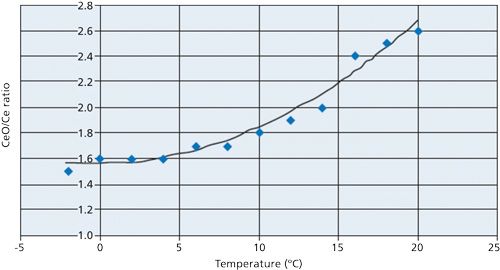
The most important maintenance procedure with regard to the spray chamber is to make sure that the drain is functioning properly. A malfunctioning or leaking drain can produce a change in the spray chamber back pressure, which can cause fluctuations in the analyte signal and result in erratic and imprecise data. The degradation of O-rings between the nebulizer-spray chamber interface can also result in poor performance because of a bad seal, or in some cases damage to the nebulizer and spray chamber. When strong acids and solvents are being used for sample preparation, O-rings can often be a source of contamination. To minimize these problems, spray chamber designs are available with an O-ring free interface (7). Typical maintenance procedures regarding the spray chamber include
- Make sure the drain tube fits tightly and there are no leaks.
- Ensure the waste solution is being pumped from the spray chamber into the drain properly.
- If a drain loop is being used, make sure the level of liquid in the drain tube is constant.
- If a pumped drain is used, make sure it is draining properly (denoted by air gaps in the liquid flow).
- Check O-ring at nebulizer-spray chamber interface, ensure that there is a good seal-replace O-rings if necessary. For O-ring free designs, ensure nebulizer is properly installed and secured.
- Check O-ring or ball joint between spray chamber exit tube and torch sample injector-ensure the connection is snug.
- The spray chamber can be a source of contamination with some matrices or analytes, so flush thoroughly between samples.
- Empty the spray chamber of liquid when the instrument is not in use.
- Spray chamber and drain maintenance should be inspected every 1–2 weeks, depending on the workload.
Plasma Torch
Not only are the plasma torch and sample injector exposed to the sample matrix and solvent, but they also have to sustain the analytical plasma at approximately 10,000 K. This combination makes for a very hostile environment and, therefore, is an area of the system that requires regular inspection and maintenance. As a result, one of the main problems is staining and discoloration of the outer tube of the quartz torch because of heat and the corrosiveness of the liquid sample, which has the potential to cause arcing, overheating, and melting of the torch (8). Another potential problem area is blockage of the sample injector because of matrix components in the sample. As the aerosol exits the sample injector, desolvation takes place and the sample changes from small liquid droplets to minute solid particles before entering the base of the plasma. Unfortunately, with some sample matrices, these particles can deposit themselves on the tip of the sample injector over time, leading to possible clogging and drift. In fact, this phenomenon can be a potentially serious problem when aspirating organic solvents because carbon deposits can rapidly build up on the sample injector and cones unless a small amount of oxygen is added to the nebulizer gas flow. The following list includes some useful maintenance tips with regard to the torch area:
- A demountable torch, where the sample injector can be changed, is highly recommended.
- Look for discoloration or deposits on the outer tube of the quartz torch. Remove material by soaking the torch in appropriate acid or solvent if required.
- Check the torch for thermal deformation. A nonconcentric torch can cause loss of signal.
- Check the sample injector for blockages. If the injector is demountable, remove the material by immersing it in an appropriate acid or solvent if required (if the torch is one piece, soak the entire torch in the acid).
- Ensure that the torch is positioned in the center of the load coil and at the correct distance from the interface cone when replacing the torch assembly.
- If the coil has been removed for any reason, make sure the gap between the turns is correct as per recommendations in the operator’s manual.
- Inspect any O-rings or ball joints for wear or corrosion. Replace if necessary.
- If a shield or plate is used to ground the coil, ensure it is always in good condition; otherwise, replace when necessary.
- The torch should be inspected every 1–2 weeks, depending on the workload.
Interface Region
The interface is the region of the ICP-MS where the plasma discharge at atmospheric pressure is coupled to the mass spectrometer at 10−6 Torr by way of two or three interface cones (known as the sample and skimmer cones). This coupling of a high-temperature ionization source such as an ICP to the metallic interface of the mass spectrometer imposes demands on this region of the instrument that are unique to the ICP-MS technique. When this system is combined with matrix, solvent, and analyte ions together with particulates and neutral species being directed at high velocity at the interface cones, an extremely harsh environment is the result. The most common types of problems associated with the interface are blocking or corrosion of the interface cones (9). A blockage is not always obvious because often the buildup of material on the cone or corrosion around the orifice can take a long time to reveal itself. For that reason, the interface cones have to be inspected and cleaned on a regular basis. The frequency will often depend on the types of samples being analyzed and also the design of the ICP-MS system. Some useful tips to prolong the lifetime of the interface cones follow:
- Check that both sampler and skimmer cones are clean and free of sample deposits. The typical frequency is weekly, but will depend on sample type and workload.
- If necessary, remove and clean cones using the manufacturer’s recommendations. Typical approaches include immersion in a beaker of weak acid or detergent placed in a hot water or ultrasonic bath. Abrasion with fine wire wool or a coarse polishing compound has also been used.
- Never insert a wire into the orifice; it could cause permanent damage.
- Nickel cones will degrade rapidly with harsh sample matrices. Use platinum cones for highly corrosive solutions and organic solvents.
- Periodically check cone orifice diameter and shape with a magnifying glass (10–20× magnification). An irregularly shaped orifice will affect instrument performance.
- Thoroughly dry cones before installing them back in the instrument because water or solvent could be pulled back into the mass spectrometer.
- Check coolant in the recirculating system for signs of interface corrosion such as copper or aluminum salts (or the predominant metal of the interface).
The frequency of cone cleaning depends very much on the application and the workload of the instrument. If the samples are clean and the usage is low, the cones may only need cleaning monthly. But if the instrument is in continuous use or the samples contain high levels of dissolved solids or are highly corrosive, the cones may need cleaning daily. The cones should be cleaned if there are visible deposits near the orifice or if the orifice is blocked or distorted. Deterioration in the performance of the ICP-MS system can also indicate that the cones may need cleaning. In particular, watch for increased background signal, memory effects, loss of sensitivity, or distorted peak shapes. A change in the instrument vacuum reading can also be an indication of cone problems. If the orifice gets blocked, the vacuum will increase (pressure decrease), although there will usually be a deterioration in performance before this point. If the vacuum decreases (pressure increases), the orifice could be worn and may have increased in size. If this happens the cone needs to be replaced.
Enhanced Productivity Tools
With the increasing demand to analyze more and more samples, carry out automated dilutions and additions of internal standards, automated sampling systems are being designed not only to maximize sample throughput, minimize sample preparation times, and increase productivity, but also to reduce exposure time of the sample matrix to the sample introduction and interface region to cut down on the frequency of cleaning instrument components. Besides significantly faster analysis times, other benefits include improved precision and accuracy, reduced carryover, and longer lifetimes of sample introduction consumables (10).
These approaches typically involve rapid sampling flow injection techniques integrated into an intelligent autosampler, which significantly reduces analysis times by optimizing the sample delivery process to reduce the pre- and post-measurement time. This can be carried out a number of different ways, but one of the most efficient is by using a fast uptake pump and multiport switching valves to control the delivery of the sample and standards to and from the ICP-MS system. When these features are combined with the use of an optimized rinse cycle as soon as the measurement of the sample is completed and rinsing the nebulizer-spray chamber during the sample flush time, it is common to see a two- or threefold improvement in sample throughput times.
An additional benefit can be realized with a programmed addition of air bubbles at the end of the sample loop. These air bubbles prevent boundary diffusion and do not allow the sample to mix with the carrier solution. This enables a smaller volume of sample to be used, which further reduces the analysis time and provides greater than a threefold decrease in washout time. The principle of injecting air bubbles into a sample loop is demonstrated in Figure 5.

To exemplify this improvement in washout time, an experiment was performed to compare the results with the bubble injector on and off. For this study, a sample flow rate of 0.22 mL/min was used with a 0.5-mL loop. The ICP-MS read delay was intentionally set to zero and 50 replicates were measured to show the available instrument read time with the bubble injector on and off. This is graphically seen in Figure 6a, which shows that with the bubble injector installed there would be approximately 84 s of available read time, compared to only 41 s with no bubble injector (Figure 6b). Figure 6b, with no bubble injector being used, clearly illustrates that the sample in the loop is beginning to be diluted by the carrier flow around replicate number 25. It’s also worth emphasizing that with the bubble injector, the blank level returns to baseline in less than 25 s compared to more than 70 s with no bubble injector.
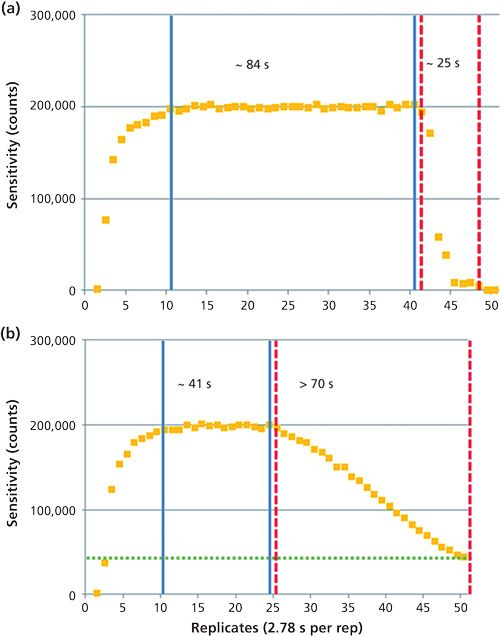
Final Thoughts
Routine maintenance cannot be over-emphasized in ICP-MS. Even though it might be considered a mundane and time-consuming chore, it can have a significant impact on the uptime of your instrument. It is essential that time be scheduled on a regular basis for cleaning and preventative maintenance procedures. However, by using specialized sampling accessories and creative approaches to cut down exposure of the sample matrix to instrument components and for some samples, removing particulate matter, there is no question that the frequency of routine maintenance can be reduced quite considerably, in addition to maximizing instrument performance. This column installment has attempted to offer some suggestions for routine maintenance, as well as some guidance to troubleshoot common problems encountered in the ICP-MS sample introduction area.
References
(1) P. Gaines, Spectroscopy20(1), 20–23 (2005). Available at:
.
(2) “Benefits of a Syringe-Driven Pump for Sample Introduction,” Glass Expansion Technical Note, available at: http://www.geicp.com/cgi-bin/site/wrapper.pl?c1=Products_accessories_assist
(3) “Performance of a Thermoelectric Flow Meter,” Glass Expansion Technical note, available at: http://www.geicp.com/cgi-bin/site/wrapper.pl?c1=Products_accessories_truflo_sample_monitor.
(4) “Selection and Care of Nebulizers,” Application Note, Glass Expansion Technical Note, available at: http://www.geicp.com/cgi-bin/site/wrapper.pl?c1=Care_gencareneb.
(5) “Care of Spray Chambers,” Glass Expansion Technical note, available at: http://www.geicp.com/cgi-bin/site/wrapper.pl?c1=Care_gencarespraychambers.
(6) “The Use of a Programmable Temperature Spray Chamber in ICP-MS,” Glass Expansion Technical Note, available at: http://www.geicp.com/cgi-bin/site/wrapper.pl?c1=Products_accessories_isomist.
(7) “A Modern Interface Between Nebulizer and Spray chamber,” Glass Expansion Technical Note, available at: http://www.geicp.com/cgi-bin/site/wrapper.pl?c1=Products_spray_learnabout.
(8) “Use and Care of Plasma Torches for ICP Spectrometry,” Glass Expansion Technical Note, available at: http://www.geicp.com/cgi-bin/site/wrapper.pl?c1=Care_gencaretorch.
(9) “Care of ICP-MS Cones,” Glass Expansion Technical Note, available at: http://www.geicp.com/cgi-bin/site/wrapper.pl?c1=Care_gencarecone.
(10) “Characterization of a Customized Valve for Enhanced Productivity in ICP Spectrometry,” Glass Expansion Application Note, available at: http://www.geicp.com/site/images/application_notes/NiagaraApplicationsWhitePaper_Feb2010.pdf.

Robert Thomas is principal of Scientific Solutions, a consulting company that serves the application and writing needs of the trace element user community. He has worked in the field of atomic and mass spectroscopy for more than 40 years and has written over 80 technical publications including a 15-part tutorial series on ICP-MS. He recently completed his third textbook entitled Practical Guide to ICP-MS: A Tutorial for Beginners. He has an advanced degree in analytical chemistry from the University of Wales, UK, and is also a Fellow of the Royal Society of Chemistry (FRSC) and a Chartered Chemist (CChem).

Ryan Brennan received his PhD in analytical chemistry from George Washington University in 2009. He was awarded a NRC Post-Doctoral appointment from 2009 to 2011 at the National Institute of Standards and Technology (NIST). Ryan’s research was focused on solving difficult analytical problems associated with sample introduction systems for ICP-OES and ICP-MS instruments. His research resulted in several publications, including two patents. Ryan is currently Product Manager of Glass Expansion, Inc. Please direct correspondence to: rbrennan@geicp.com

Jerry Dulude received his Bachelor of Science degree from the University of Massachusetts at Amherst in 1973 and his Masters of Science in analytical chemistry from the University of Massachusetts at Lowell in 1982. He began his career working with electro analytical techniques and moved into atomic spectroscopy in 1979. Mr. Dulude occupied several positions at Thermo Scientific including AA product manager, applications scientist, and consumables product manager. He is currently president of Glass Expansion, Inc. Please direct correspondence to: jdulude@geicp.com
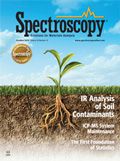
Applications of Micro X-Ray Fluorescence Spectroscopy in Food and Agricultural Products
January 25th 2025In recent years, advances in X-ray optics and detectors have enabled the commercialization of laboratory μXRF spectrometers with spot sizes of ~3 to 30 μm that are suitable for routine imaging of element localization, which was previously only available with scanning electron microscopy (SEM-EDS). This new technique opens a variety of new μXRF applications in the food and agricultural sciences, which have the potential to provide researchers with valuable data that can enhance food safety, improve product consistency, and refine our understanding of the mechanisms of elemental uptake and homeostasis in agricultural crops. This month’s column takes a more detailed look at some of those application areas.